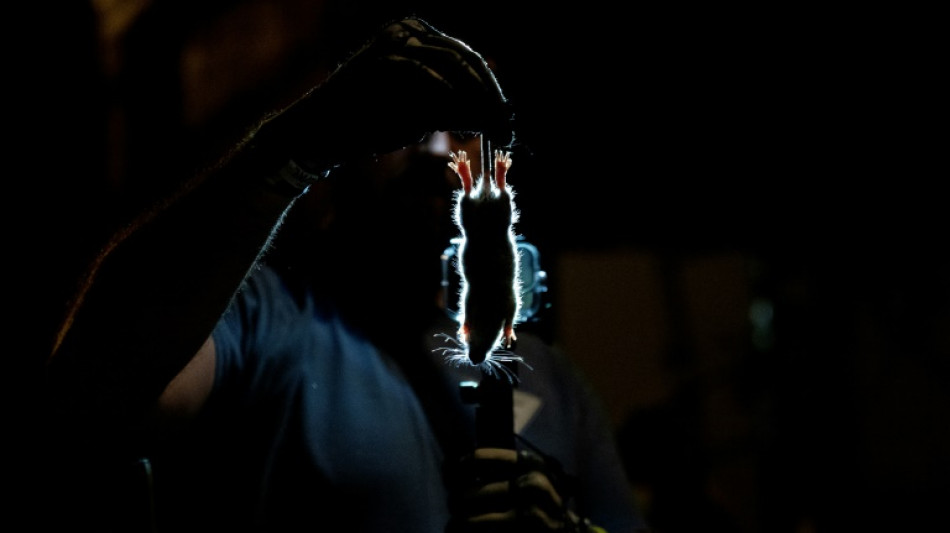
SCS
0.2300

On a hot June night, revelers descend on Washington's Adams Morgan neighborhood, a nightlife and dining hotspot in the US capital. But they aren't the only ones profiting from the good weather.
Also out in number are the city's rapidly growing population of rats, which prowl the alleys behind the restaurants, bars and clubs, feasting on leftovers tossed out in the trash.
The rodents' merrymaking comes to a swift halt amid a flurry of barks, gnashing teeth and splattered blood: the result of a hunt involving a dozen humans and their hounds out on a weekly "ratting" expedition.
"Good boy, Henry!" Marshall Feinberg, a 28-year-old dog trainer, cries out as his lurcher claims the night's first kill.
The District of Columbia consistently makes the top five list of America's rattiest cities, a problem made worse by warming winters, a rising population, and outdoor dining areas made permanent after the Covid pandemic.
There were nearly 13,400 calls to a city hotline for rat issues in 2022, up around 2,000 on the year before, according to local media reports. Now, some residents are fighting back.
The putrid stench of garbage mixed with urine fills the air as the posse pushes forward. Their dachshunds, terriers and sighthounds dart beneath dumpsters in pursuit of their quarry.
- Diverse dogs, humans -
Like their dogs, the humans are a diverse lot: Black and white, old and young. Some are from the city or its suburbs while others have traveled from neighboring states, after connecting with fellow ratting enthusiasts through social media.
Bomani Mtume, a 60-year-old retired police officer who's here with Barto, his Cairn Terrier (the same breed as Toto from "The Wizard of Oz"), joined the group in March just as it started out.
"When we first hunted, they didn't even run -- they just looked at the dogs," he said of the rats, explaining the predation that has since made them more skittish.
"Even dogs that don't know each other start working together, it's a beautiful thing," he adds.
Teddy Moritz, a 75-year-old nicknamed "Grandma Death," is something of a legend in the hunting dog community, and has brought her son and teenage grandson with her from Delaware.
"It's a good way to organically control rats," she says, explaining rat poison takes several days to exterminate the vermin, while dogs quickly snap their spines, preventing them from feeling anything. "Primitive but effective," she adds.
Spry and full of stamina, Moritz stamps her feet at a dumpster to redirect an escaping rat back towards the dog pack. A longtime breeder, she helped establish a lineage of dachshunds that team up with falcons to hunt rabbits, and are now used in ratting.
Over the course of three hours, the team racks up more than 30 kills, before disposing of them in trash cans.
"What you saw basically was the definition of teamwork. It was dogs and people working together and trying to do good pest control to help our city," says Feinberg.
Rodentologist Bobby Corrigan told AFP that while there was little scientific data yet to validate the efficacy of ratting, such practices date back hundreds of years when dogs were trained for pest control at farms.
"There's no doubt about it -- these days, dogs are making a resurgence in being used as a rat control tool," with commercial demand rising.
Moreover, said Corrigan, poison has been shown to harm species such as hawks and owls, and snap traps can take days to kill rats, making hunting the more humane option.
- A beloved employee -
Dogs aren't the only hunters tackling the city's rodent problem -- so too are cats, which prey mainly on mice.
Lisa LaFontaine, president of the Human Animal Rescue Alliance, told AFP her organization started the "Blue Collar Cats" program for the city's feral feline population in 2017, and had now matched 400 strays to local businesses.
"We conceived this program as a way to give the cats the lives that they had always had, but do it in a way where they had all the vaccines they needed," she said.
Twenty minutes out of the city in the town of Alexandria, Rue the cat has helped keep at bay the mice that once chewed through bags of birdseed and fertilizer at the Greenstreet Growers garden center.
"She kills some of the mice, but she's just as much as a deterrent," explains Tim Williams, director of operations, who estimates the business' losses have shrunk to 10 percent of what they once were.
Rue's considered a star employee, and has a following on Instagram.
"It's a fantastic twofold benefit of having the cat here, everyone loves seeing her," says Williams.
O.Pereira--NZN